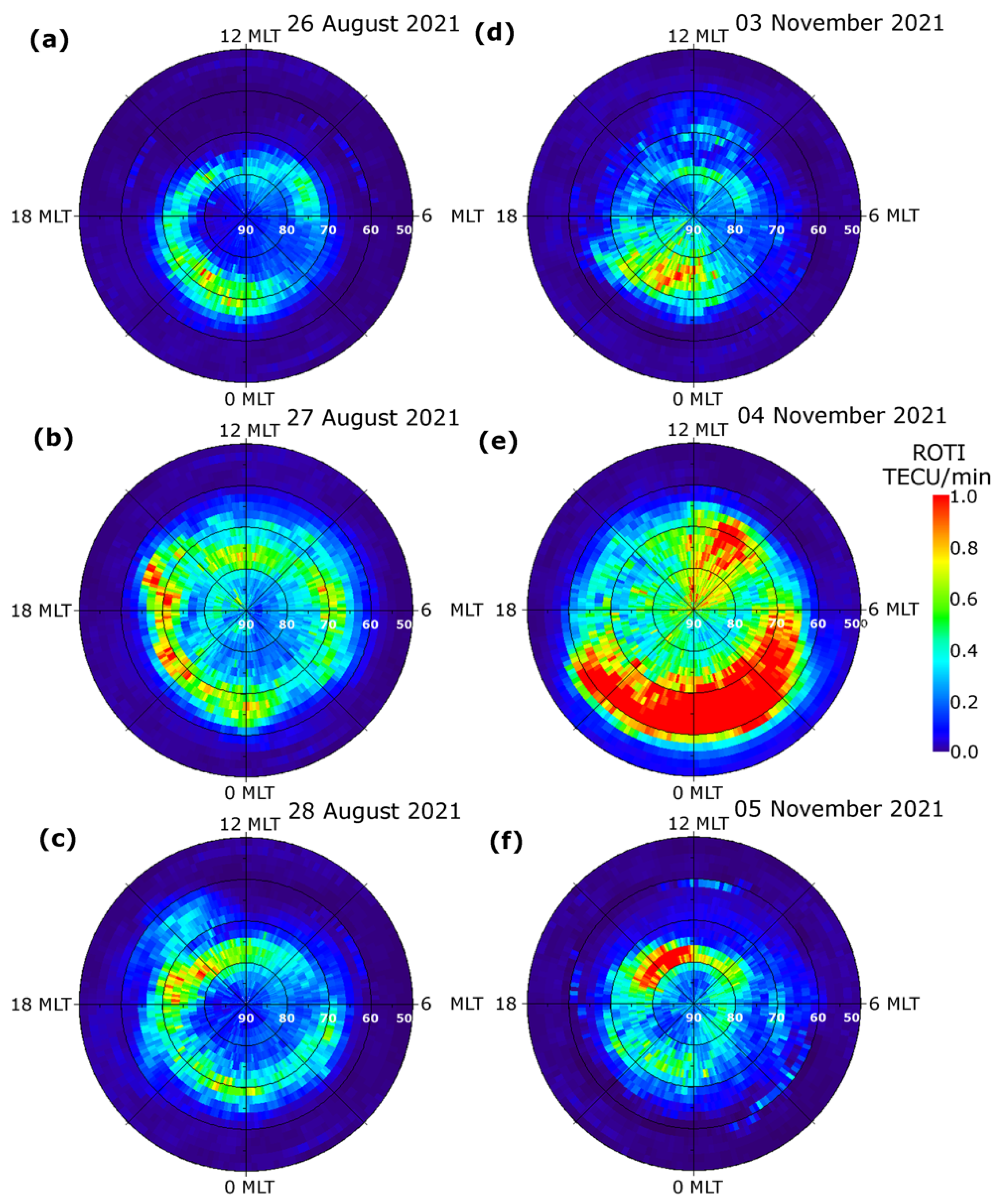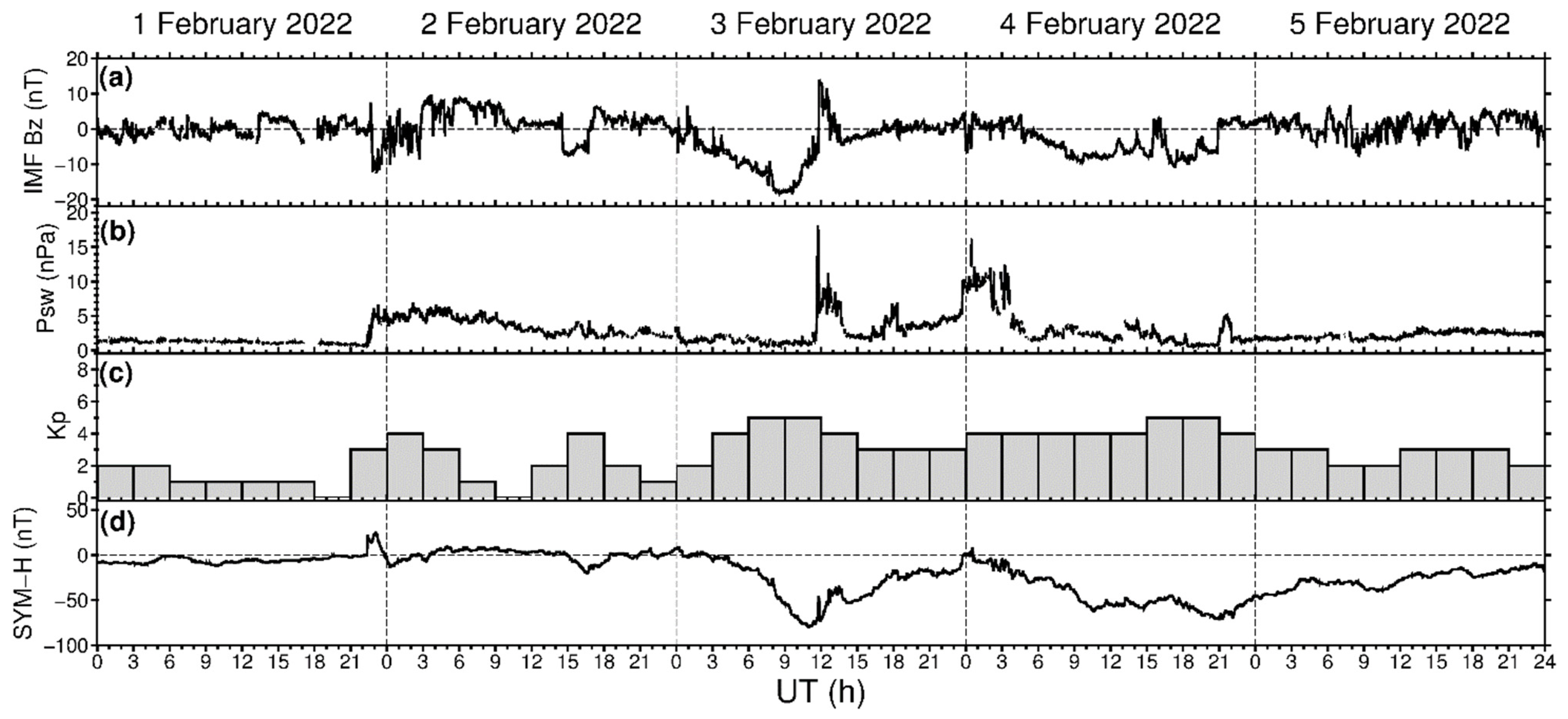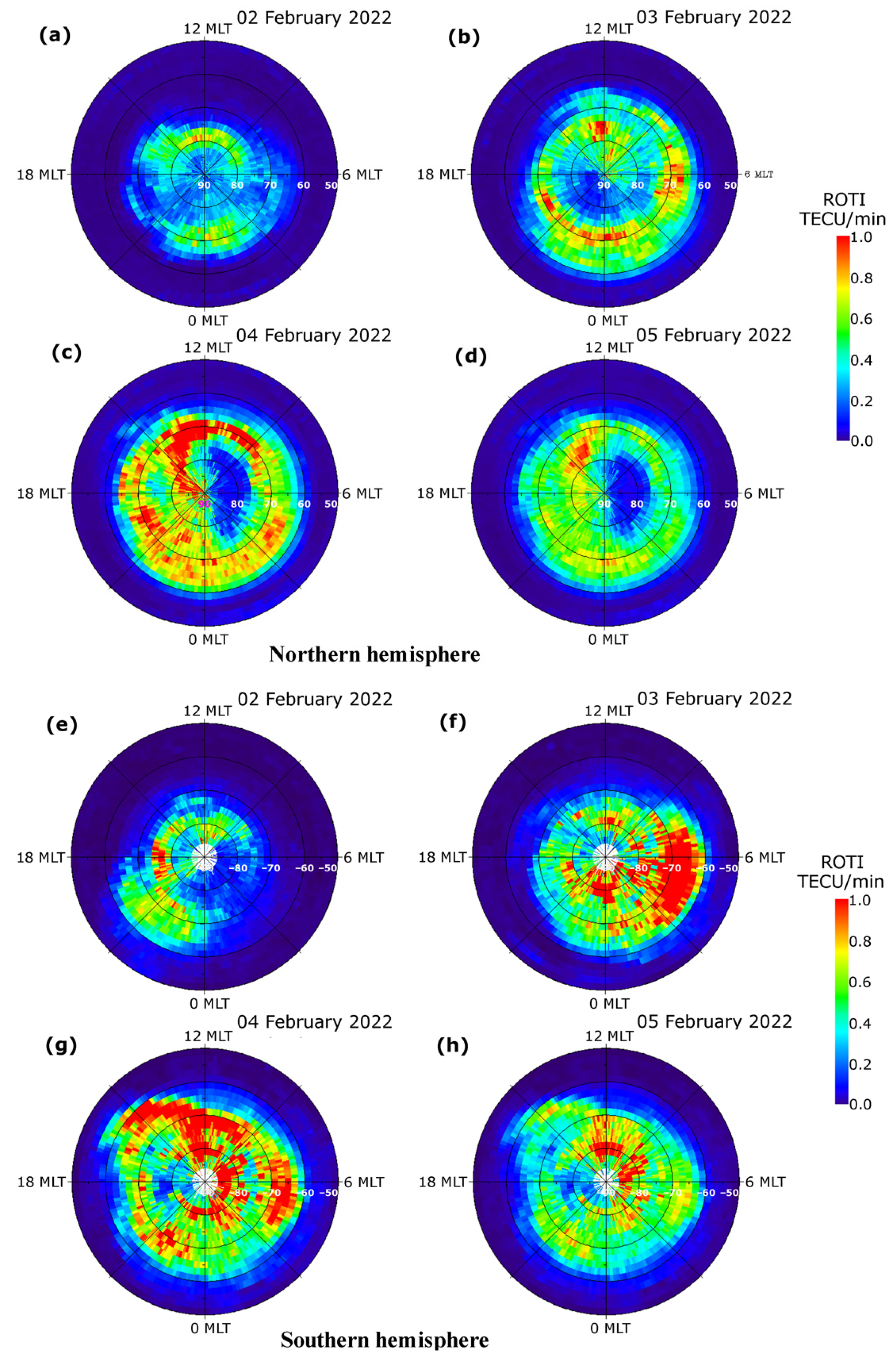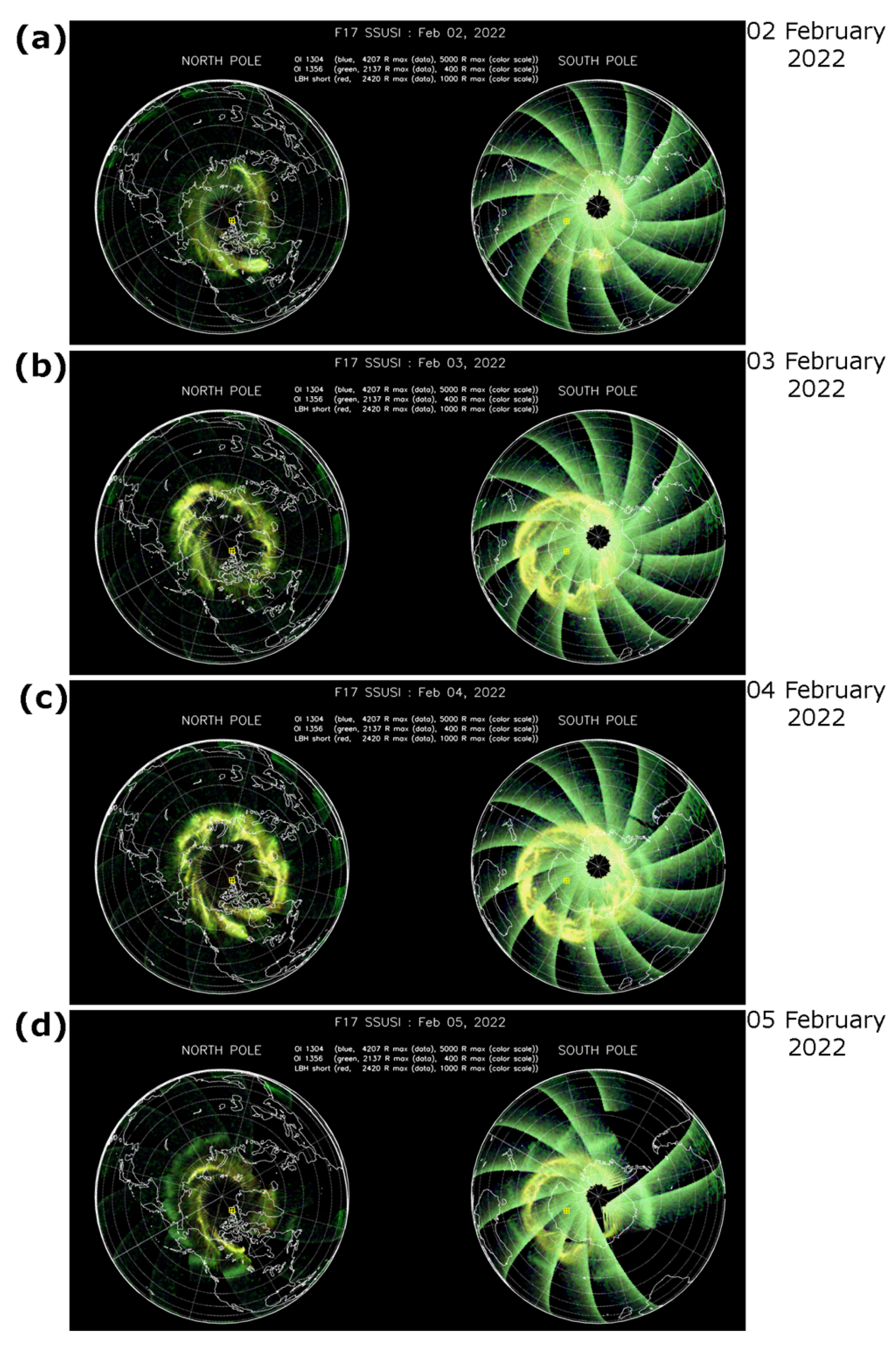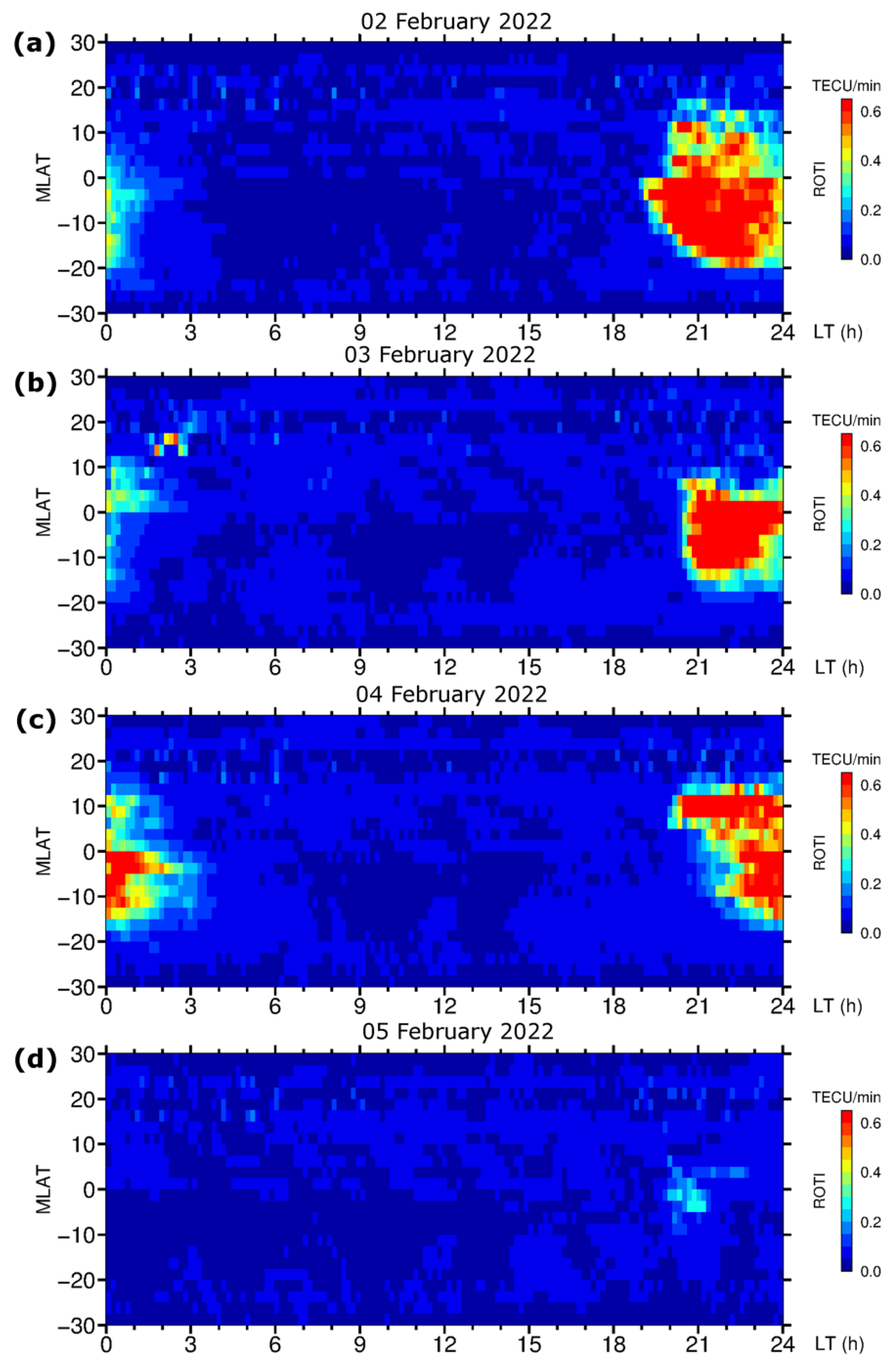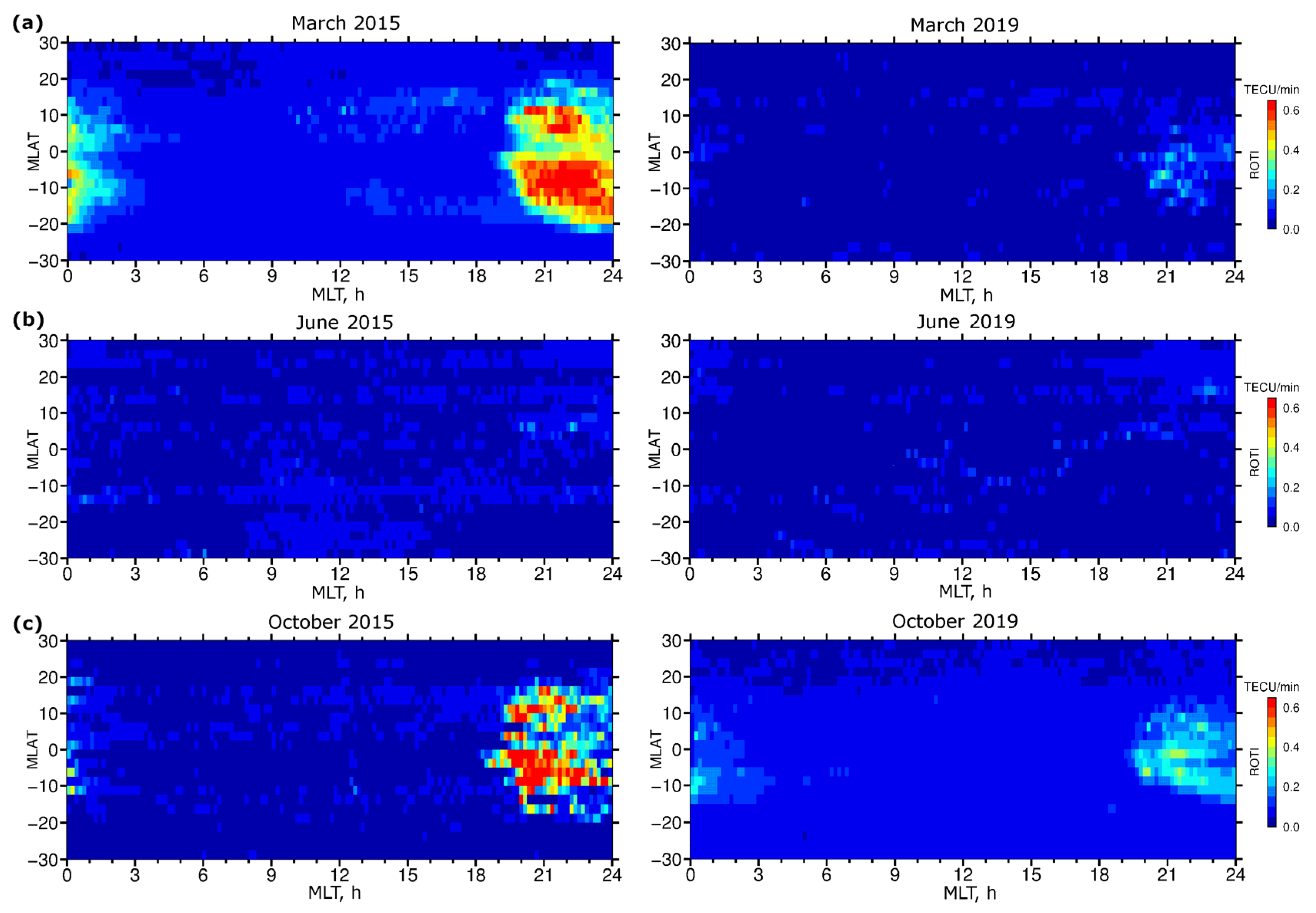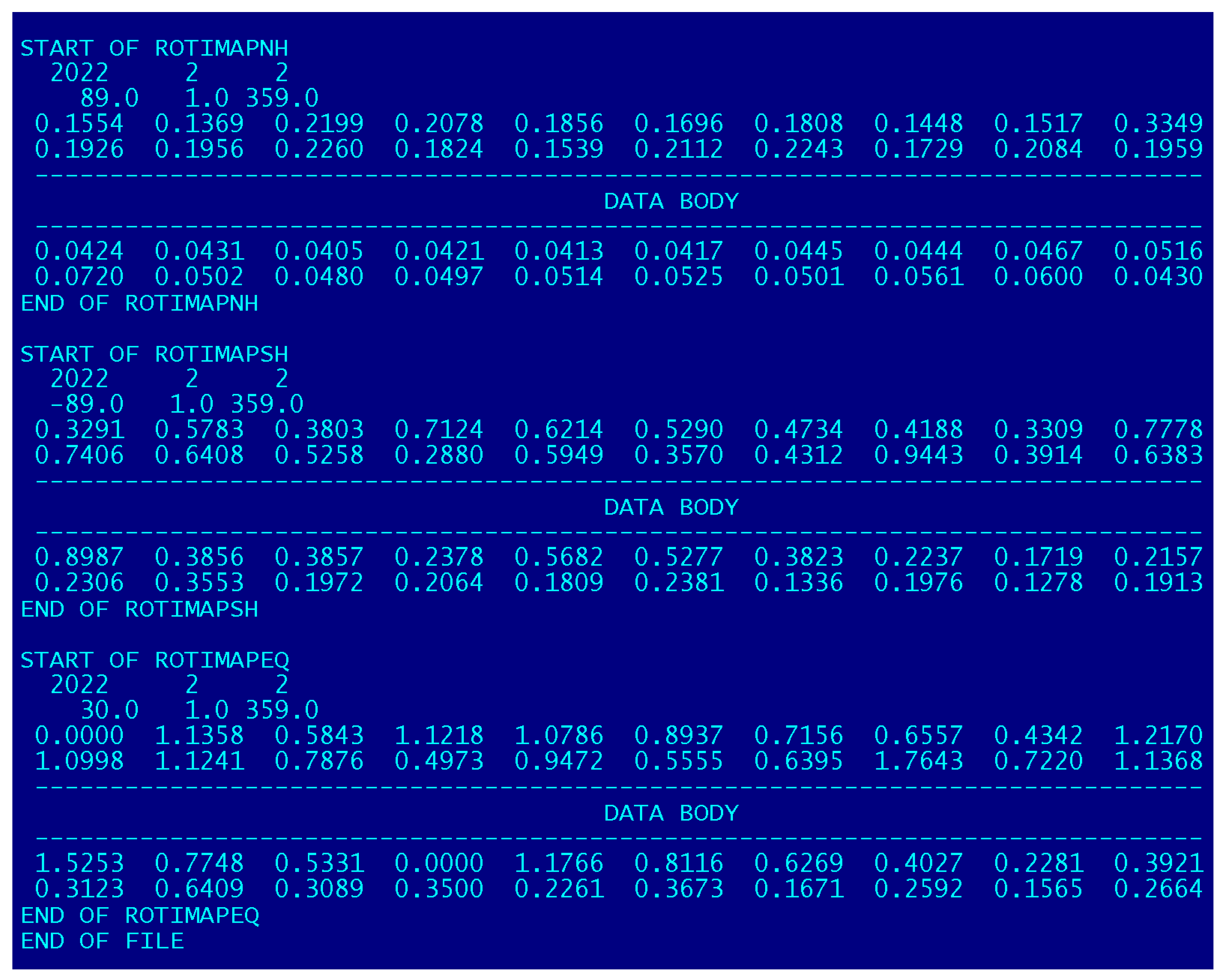3.1. IGS ROTI Maps Product: Current Status
Since 2014, the UWM analysis center for IGS collects and processes data, generates ROTI maps on their basis, and sends them to the IGS server. A software was developed for the regular transfer of observational and navigational files from the IGS, EPN, CORS, and UNAVCO databases. Each day, the raw GPS observations in the RINEX format are downloaded, decompressed, and tested for consistency and quality to fill up the local database. Next, the observational data for a considered day is processed using the ROTI mapping approach as discussed in
Section 2. The center provides ROTI maps product that supports regular monitoring of the ionospheric irregularities occurrence over the Northern hemisphere and this product is available for the community via the NASA CDDIS (Crustal Dynamics Data Information System).
Currently, the ROTI maps become available for the period from 2010 to present. Following the IGS Ionosphere Working Group recommendation, the ROTI maps product is accessible at the CDDIS data portal in the same folder “IONEX” such as IONEX TEC GIMs for a particular day. Users can download the ROTI map data file with the name mask rotiDDD0.YYf where the “roti” is a product acronym, DDD stands for the Day-Of-Year (DOY) and YY for the last two-digit of the year. For example, the ROTI map product datafile for the day of 1 January 2022 is marked as roti0010.22f. The reader is referred to [
10] for more details on ROTI maps production. The main updates are as follows.
The most important changes happened recently with the NASA CDDIS access rules. Since October 2020, the NASA CDDIS discontinued anonymous ftp access to its archive and moved from simple ftp to secure access protocols (https and ftp-ssl). Now for data assessment, user accounts and new secure access protocols are mandatorily required. The data samples may be downloaded by following the links:
https://cddis.nasa.gov/Data_and_Derived_Products/CDDIS_Archive_Access.html (accessed on 27 April 2022) and
https://cddis.nasa.gov/About/CDDIS_File_Download_FAQ.html (accessed on 27 April 2022). These changes were also accounted for in the UWM ROTI processing as part of procedures for download of the observational and navigational files from the IGS network hosted at the NASA CDDIS. When operating UWM ROTI maps processing we continuously monitor the availability and data latency of GPS RINEX observations over the Northern hemisphere in IGS, UNAVCO, CORS, and EPN networks. As a result, roughly 700 permanent GPS stations are selected to serve as an input database and we update the list of selected representative stations on a yearly basis to keep a consistent amount and distribution of core observations.
To demonstrate the performance of the product under different geomagnetic conditions, we presented a series of the visualized IGS ROTI maps product for the Northern hemisphere during two geomagnetic storms of the 25th solar cycle (
Figure 1). The first geomagnetic storm of 27–28 August 2021 was associated with the 26 August C3-class flare and the following coronal mass ejection (CME) arrival. The IMF Bz southward turning occurred after 13 UT on 27 August 2021 and the IMF Bz remained steady negative for more than 14 h till ~04 UT on 28 August 2021. During that time, the main phase of the storm developed starting from ~13 UT on 26 August 2021; the Dst index reached its minimum value of –90 nT at 00:25 UT on 28 August 2021. The highest value of the Kp index for this storm was 5 at 00 UT on 28 August 2021. The auroral activity level increased significantly on 27 August 2021 when the auroral electrojet index AE index reached the values of more than 1000 nT with isolated peaks up to 1500–2000 nT. On the ROTI map corresponding to 26 August 2021 (
Figure 1a), one can recognize a belt-like structure with ionospheric irregularities occurrence of relatively weak intensity as revealed by ROTI near 70–78° N MLAT. We should note that these pre-storm conditions were weakly disturbed due to the previous geomagnetic disturbance that occurred on 25 August 2021. Under such conditions, the ionospheric irregularities detected by ROTI at high latitudes can be produced by auroral particle precipitations from the disturbed magnetosphere. On the next day, 27 August 2021 (
Figure 1b), when the main phase of the storm was developed the ROTI map allowed us to detect the intensification of the ionospheric irregularities development and extension of irregularity oval from ~70–75° MLAT towards lower latitudes at ~65° MLAT in both the dayside and nightside sectors. In the afternoon and evening sectors, the intensity of irregularities exceeded 0.6 TECU/min. The ROTI map constructed for the recovery phase on 28 August 2021 (
Figure 1c), shows the presence of the ionospheric irregularities with a moderate intensity level of ~0.5 TECU/min, and the irregularities oval shrank with its equatorward border located at ~70° MLAT at the night sector but it did not reach the pre-storm level at the dayside sector.
The geomagnetic storm of 4 November 2021 was classified as a G3—strong geomagnetic storm. As it was reported by the National Oceanic and Atmospheric Administration (NOAA) Space Weather Prediction Center, this storm was related CMEs that occurred on 1–2 November 2021 and arrived with the high-speed solar wind in the Earth magnetosphere on 3 November 2021. During the main phase of the storm on 4 November, the Kp index reached the maximal value of 8- and the Dst index dropped down to −118 nT. Aurora lights produced by this storm were reported for many locations in USA and Canada in the Northern hemisphere and in New Zealand in the Southern one.
Figure 1d–f presents a series of the daily ROTI maps illustrating the occurrence and intensity of the high-latitude ionospheric irregularities for the period of 3–5 November 2021. These ROTI maps for the Northern hemisphere illustrate an evolution of the ionospheric fluctuation pattern before the storm’s commencement (3 November, panel d), large intensification of ionospheric irregularities during the main phase of the storm (4 November, panel e), and ionospheric conditions at the recovery phase of geomagnetic disturbance (5 November, panel f). On the day before the storm, the intense irregularities were located mainly in the nighttime sector (20–00 MLT) within the latitudinal range of 70–80° MLAT, and their occurrence can be related to the quiet-time particle precipitation from the magnetotail into the nightside ionosphere. During the main phase of the storm, it was registered a strong intensification of plasma irregularities characterized by the ROTI values increasing up to 1.0 TECU/min (which indicates the presence of strong ionospheric plasma gradients), and the equatorward border of the irregularities oval expanded towards 55° MLAT in the nightside sector. On the ROTI map constructed for 4 November 2021, besides the large expansion of the irregularities oval one can note the presence of the structures elongated from dayside (9–12 MLT sector) towards the geomagnetic pole that can be associated with the formation of the SED–TOI (storm-enhanced density and tongue of ionization) structures which follow the convection pattern anti-sunward across the polar cap region. During the recovery phase of the geomagnetic storm, the fluctuation activity pattern on 5 November 2021 (panel f) revealed a considerable poleward shrinking of the zone with intense ionospheric irregularities, and they were registered again mainly near the cusp area and in the evening sector.
3.3. Extension of the IGS ROTI Maps Product: Performance Evaluation
The performance of the new ROTI maps for the Southern hemisphere and equatorial region can be assessed by their ability to represent the well-known features of ionospheric irregularities development over these areas. To demonstrate the performance of the ROTI maps over high/middle latitudes of the Southern hemisphere, we carried out the comparative study of irregularities development specified by ROTI maps for both the Northern and Southern hemispheres for the case of the recent geomagnetic storm that occurred in February 2022.
Figure 3 presents temporal changes in the major geophysical parameters during 1–5 February 2022. The resultant product was visualized in the form of a series of ROTI maps in polar projections for both the Northern and Southern hemispheres (
Figure 4). The visualization grid size is 2° MLAT by 0.13 h (8 min) MLT, which corresponds to 20 × 180 sector bins. We utilized a color scale ranging from 0.0 to 1.0 TECU/min, where the ROTI values below 0.2 TECU/min, specified by dark blue color, represent very weak or absence of ionospheric irregularities, whereas the ROTI values higher than 0.8–1.0 TECU/min, specified by orange and red color, indicate the presence of strong ionospheric irregularities within that particular cell. In maps of the Southern hemisphere, we have “no data” area marked by white color due to an absence or insufficient observational data over the Southern magnetic pole.
The first CME arrived at ~22:20 UT on 1 February 2022 which caused geomagnetic field disturbances with a rapid increase of the Dst/SYM-H index from 0 to 25 nT and an increase of the Kp index to 3–4 (
Figure 3). Intensification of geomagnetic activity led to an occurrence of high-latitude ionospheric irregularities due to auroral particle precipitation and high-latitude ionospheric electric fields. For 2 February 2022, the ionospheric irregularities were clearly detected at high latitudes; they were localized mainly at ~75–80° N MLAT in the dayside and at ~70° MLAT in the nightside sector of the Northern hemisphere (
Figure 4a). Over the Southern hemisphere (
Figure 4e), localization of the ionospheric irregularities in the dayside sector was quite similar to the Northern hemisphere, but in the nightside sector, the zone of noticeable irregularities was shifted from midnight to 20–21 MLT. On 3 February 2022, the main phase of the geomagnetic storm (identified by the SYM-H index) developed with the SYM-H index decrease reaching its minimal value of –80 nT at ~11 UT, whereas the Kp index reached 5 (
Figure 3). The series of the next maps corresponded to a period of increased geomagnetic activity. In comparison with observations for the previous day, the daily ROTI maps for 3 February 2022 demonstrate a significant intensification of ionospheric irregularities occurrence with ROTI values exceeding 0.9–1.0 TECU/min over both hemispheres, as well as a simultaneous expansion of the irregularities oval area in the poleward and equatorward directions (
Figure 4b,f).
The irregularities oval expanded equatorward down to 60° N MLAT in the nightside sector, and the location of its equatorward edge is in the vicinity of the main ionospheric trough and the auroral oval equatorial edge. In the dayside sector (top part of the polar maps), the strong ionospheric irregularities were detected over 75°–80° N MLAT, which can be related to the dayside aurora and particle precipitation into the dayside cusp. The poleward-oriented structures in both the dayside and nightside sectors can represent signatures of the storm-induced ionospheric plasma dynamic processes, such as the polar cap patches that follow the convection pattern across the polar cap. The pronounced hemispheric asymmetry is registered in the morning sector (03–08 MLT) with a more intense irregularity occurrence in the Southern hemisphere. On 4 February 2022, the second geomagnetic storm developed after a short recovery phase of the first storm.
Additionally, we examined the optical observation of the ionosphere by the Special Sensor Ultraviolet Spectrographic Imager (SSUSI) which measures far ultraviolet emissions in five different wavelength bands (HI 121.6 nm, OI 130.4 nm, OI 135.6 nm, N2 LBHS (140–150 nm) and N2 LBHL (165–180 nm)) from the Earth’s upper atmosphere [
14]. These channels capture the main auroral UV emissions.
Figure 5 shows summary SSUSI images as a daily accumulation of all nightside passes of the DMSP F17 satellite across the Northern and Southern Pole regions during 2–5 February 2022. For 2 February (
Figure 5a), the SSUSI-detected auroral emissions were localized at high latitudes with the brightest emission over Canada in the Northern hemisphere and near the Antarctica continent in the Southern one. On 3 February (
Figure 5b), when the first geomagnetic storm developed, the overall brightness of auroral emission increased in comparison with the previous, comparatively quiet day, and the oval-like shape of the aurora was clearly seen expanded in size even at the background of the sunlight summer conditions over Antarctica in the Southern hemisphere. One can see an expansion of auroral oval towards lower latitudes: for the Northern hemisphere—towards the south of Greenland, Iceland, north of Russia, for the Southern hemisphere—mostly towards Australia and New Zealand. For 4 February (
Figure 5c) the aurora brightness was also high and the auroral oval expanded in the similar directions as on the previous day. For 5 February (panel c), the brightness of auroral emissions captured by SUSSI was decreased and the auroral oval size returned practically to the pre-storm conditions of 2 February 2022. So, aurora evolution tracked by the SUSSI instrument has a good consistency with ionospheric irregularities oval behavior represented by ROTI maps—rather weak and narrow on 2 February 2022, intensification during two geomagnetic storms developed on 3 and 4 February 2022, and return to the more quiet conditions on 5 February 2022.
The 3–4 February 2022 event was a moderate geomagnetic storm, but this event had a significant impact on the about 40 SpaceX satellites that were launched on 3 February 2022, and the next day they reentered the Earth’s atmosphere, as was reported by SpaceX. One of the possible reasons can be related to an increased satellite drag due to thermospheric heating. The effects of thermosphere density increased due to thermosphere heating and impact on satellite drag is a well-known phenomenon reported in [
15,
16,
17,
18]. During geomagnetic storms, the predominant sources of this thermosphere heating are Joule heating by electrical currents and particle precipitation from the magnetosphere [
19]. The initial response at high latitude is that Joule heating raises the temperature of the upper thermosphere and ion drag drives high-velocity neutral winds. The energy comes to the thermosphere primarily through high latitudes and propagates towards the equatorial region with gravity waves and wind surges [
20]. Large-scale traveling ionospheric disturbances (LSTIDs) represent an ionospheric manifestation of this phenomenon. In [
21], with joint analysis of the ionospheric plasma irregularities, FACs, and LSTIDs reveals that a zone with the intense FACs and auroral ionospheric irregularities we reported that the area where this thermosphere heating can occur (LSTIDs excitation zone) is in the same time and location where most intensive ionospheric plasma irregularities detected by the ROTI technique are developed. The plasma irregularities produced by particles precipitation and magnetospheric fields and currents which parts of the energy deposition process. The ROTI-specified irregularities oval and extension of this oval towards midlatitudes are related with the start of magnetospheric energy deposited to the thermosphere intensification with following atmospheric waves propagation towards the equator, increased thermosphere density, and corresponded satellite drag. So, the development of intense ionospheric irregularities at high/suboral altitudes indicated the first chain of processes leading to satellite drag increase, and the ROTI maps product could help to reconstruct the conditions leading to drag enhancement in a space-weather-oriented framework.
The polar ROTI maps corresponded to the most active periods of these geomagnetic storms for 3 and 4 February 2022 (
Figure 4) clearly demonstrate the occurrence of intense ionospheric irregularities in the form of a large-scale oval extended as far equatorward as 60° MLAT in both hemispheres. The high-latitude ionospheric irregularities were driven by an enhanced auroral activity due to auroral particles’ precipitation, ionospheric conductivity, and current enhancements. Presence of signatures of intense ionospheric irregularities and irregularities of oval expansion on the ROTI maps of both hemispheres can be considered not only as threatening conditions for transionospheric radio waves propagation and for GPS performance degradation but also as a proxy for a storm-time atmosphere heating phenomena responsible for atmospheric drag enhancement.
The equatorial ionosphere response to geomagnetic storms is also of interest. During geomagnetic disturbances, the effects of prompt penetration electric fields (PPEFs) and disturbance dynamo electric fields (DDEFs) can largely transform the occurrence of typical equatorial plasma bubbles. Generally attributed to the sudden southward turn of the IMF Bz, the PPEFs appeared in the equatorial region instantaneously [
22,
23]. The PPEFs are usually eastward during daytime (upward drift), and its superposition with the normal pre-reversal enhancement can produce much larger upward vertical drifts in the local postsunset sector [
24]. The DDEFs need more time to develop (several hours after a storm commencement) and they are long-lived. The DDEFs are driven via global scale thermospheric wind circulation due to Joule heating at high latitudes [
25]. Typically, the DDEFs are westward during daytime (downward drift) and eastward at nighttime (upward drift). Therefore, the eastward PPEFs that appeared in the local sunset zone can result in a strong upward plasma drift that led to storm-induced equatorial plasma bubbles development. With further storm development, the dominating DDEFs can cause downward plasma drift in the local sunset regions that result in the suppression of postsunset equatorial plasma bubbles during the storm’s recovery phase.
Figure 6 presents a day-by-day sequence of the ROTI maps for the equatorial region for 2–5 February 2022. The maps indicated the occurrence of intense equatorial ionospheric irregularities in the local postsunset period after ~19 LT. Their latitudinal extension was within ±20° MLAT. For 2 February 2022, the equatorial irregularities dissipated close to the local midnight (00–01 LT). For the first geomagnetic storm on 3 February 2022, the signatures of the ionospheric irregularities were detected further in the nighttime till 02–03 LT. For 4 February 2022, during the next phase of the geomagnetic storm, the ROTI map shows the presence of ionospheric irregularities mainly after 21LT (2 h later than on the less disturbed day of 2 February) and they persisted for a much longer period after midnight, up to 3 LT and had a much higher intensity comparing to the previous days. For 5 February 2022, during the recovery phase, we can see strong suppression of the postsunset equatorial ionospheric irregularities most possibly associated with the action of the storm-induced DDEFs. This variability was driven by complex processes that affected the equatorial ionosphere during a geomagnetic storm.
The ionospheric plasma depletion associated with the equatorial plasma bubbles development can be detected using NASA’s Global-scale Observations of the Limb and Disk (GOLD) instrument from the geostationary orbit by analyzing Earth’s airglow emissions [
26]. The series of GOLD images in
Figure 7 demonstrates examples of the GOLD detection of the equatorial plasma bubbles over the South America sector during the considered period in February 2022. The equatorial plasma bubbles signatures (dark narrow C-shape strips seen at both sides from the magnetic equator marked by a solid black line) were well revealed on the days 2 and 3 February 2022. During the next days, 3 and 4 February 2022, the GOLD images show suppression of the equatorial plasma bubbles during that time. These independent observations are in good agreement with the effects captured by ROTI maps, where we also can see intense irregularities at postsunset hours on 2 and 3 February 2022, and graduate decrease of the irregularities’ occurrence on 4 February 2022, and suppression on 5 February 2022. The presence of irregularities on the ROTI map corresponded to 4 February, which is different from the GOLD results, can be explained by the fact that the daily ROTI map was constructed using observations from GPS stations at all longitudes, whereas GOLD was focused on the American-Atlantic sector.
For further analysis of the extended ROTI maps performance constructed for the equatorial region, we focused on the periods that corresponded to the different conditions for equatorial irregularities development. From the earlier studies on the climatology of equatorial plasma bubbles development responsible for the occurrence of intense ionospheric irregularities in the equatorial region, there are determined so-called “bubble seasons” that can be different for different longitudinal sectors. Under the quiet conditions, high bubble season can be normally attributed to periods close to the fall/spring equinoxes and low bubble season corresponds to the June solstice practically for all sectors. The important feature of the equatorial plasma bubbles occurrence is their seeding and development during local postsunset hours and the rate of the bubbles dissipation after local midnight. However, during geomagnetic disturbances prompt penetration of the magnetospheric electrical fields can create favorable conditions for the plasma bubbles development even during a low bubble season, as well as outside postsunset hours, e.g., after midnight and pre-sunrise hours.
Figure 8 presents diurnal ROTI maps constructed for the equatorial region and low latitudes (30° S–30° N MLAT) for the representative periods of March, June, and October at high (2015) and low (2019) levels of solar activity. For the examined periods, the ROTI maps allow us to recognize the occurrence of the ionospheric irregularities associated with the equatorial plasma bubble phenomenon during local postsunset hours, i.e., after ~19 LT. The pre-reversal enhancement of the postsunset vertical plasma drift led to the growth of the Rayleigh–Taylor instability resulting in equatorial plasma bubbles development. Typically, the equatorial plasma bubbles are generated after sunset and the peak height of the bubble rise above the magnetic equator (apex altitude) can determine the latitudinal extent of the bubble from the magnetic equator. The ROTI maps revealed the presence of ionospheric irregularities as detected by GPS ROTI on both sides of the magnetic equator. The ROTI maps also show some differences in the irregularities’ patterns for the considered period, in particular intensity, time of irregularities onset, and their persistence after local midnight. In these examples, the most intense and prolonged in time ionospheric irregularities developed during the high “bubble season” in the solar maximum period (
Figure 8a,c, left panels), and the weaker signatures were registered during the low solar activity period (
Figure 8a,c, right panels). June solstice is traditionally considered a low “bubble season” period with the lowest probability to observe postsunset equatorial plasma bubbles around the globe e.g., [
27,
28].
Figure 8b illustrates well the lowest intensity of the ROTI values in the equatorial region during both the high (June 2015) and low (June 2019) solar activity. The intensity, as well as latitudinal and temporal extensions of equatorial ionospheric irregularities detected by ROTI maps, are related to the increase of background electron density due to solar flux variations. The ROTI maps are sensitive to reproducing such types of ionospheric irregularities variations.
